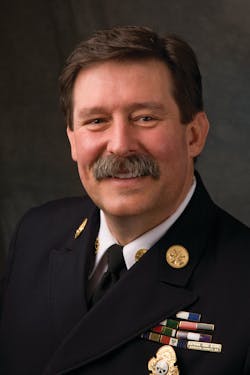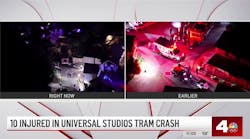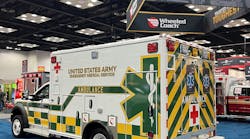The images have become iconic: A firefighter wrestles with a news photographer who refuses to stop taking pictures of the treatment of a patient. A police officer arrests a cameraman who refuses his orders to stop taking pictures. A paramedic pushes the lens of a camera, prompting fighting words from the photographer.
While iconic, the images are also ironic as confrontations over photography have themselves been captured in photos. There have been numerous cases in recent years in which fire, EMS and law enforcement personnel have found themselves at odds with photographers at emergency scenes. A few cases have ended up in federal court, where emergency responders have been taught an expensive lesson about the First Amendment rights of photographers.
How do dedicated, caring professionals who come to work every day committed to helping people find themselves accused of civil rights violations? Do emergency responders have the right to limit what photographers can photograph? Does it matter whether the photographer is a credentialed member of the media or just some busybody with a cell phone camera? Those are the questions this column will address.
Why does this happen:
Our training & our culture
The emergency services – fire, EMS and law enforcement – have distinct organizational cultures. Often, our cultures drive our decision-making, leading us to act in ways that are consistent with our cultural values.
Firefighters and emergency medical personnel are trained to respect and protect the privacy rights of patients and victims. This training is reinforced regularly and bolstered by concerns over the Health Insurance Portability and Accountability Act (HIPAA) and medical confidentiality. As a result, safeguarding patient privacy becomes ingrained in the culture of fire and EMS organizations.
Police officers are trained to take command at a scene as a strategy to prevent the unruly behavior of a few bystanders from causing a situation to get out of control. Officers learn that letting one unruly person disregard their instructions can prompt others to follow suit, leading a tense emergency scene to devolve into chaos. The result is that police officers are conditioned to issue authoritative verbal commands to citizens and enforce those commands when they are ignored.
Both of these aspects of emergency service culture are understandable, but both can predictably lead to a direct clash with photographers at emergency scenes.
The law
The First Amendment to the U.S. Constitution reads:
Congress shall make no law respecting an establishment of religion, or prohibiting the free exercise thereof; or abridging the freedom of speech, or of the press; or the right of the people peaceably to assemble, and to petition the Government for a redress of grievances.
Among the rights directly referenced in the First Amendment are freedom of speech and freedom of the press. While freedom of speech clearly extends to all people, a question that commonly arises today with regards to freedom of the press is: Who exactly is “the press”?
In the 1700s, members of “the press” either owned or worked for someone who owned the only means of mass communication – a printing press. Over the years, freedom of the press has been understood to protect the media from government censorship, as well as prohibiting government from restricting a reporter’s right to cover newsworthy stories.
How do we define “the press,” written into the Constitution in the 1791, in the age of 24-hour cable news, computers and the Internet? Isn’t a simple photocopier or even a printer the equivalent of a 1700s printing press? And what about electronic news – Tweets and blogs – that doesn’t even require “printing”? Is someone with a blog a member of the press? How about a 13-year-old with a Facebook page?
The U.S. Supreme Court has long held that the First Amendment protects the rights of individual citizens to produce and publish their own newsletters and publications without governmental interference. In 1938, in the case of Lovell v. City of Griffin, the court broadly defined the press as “every sort of publication which affords a vehicle of information and opinion.”
Following that reasoning, the court has concluded that everyone – each of us – has a constitutional right to cover the news equal to that of the traditional “press”. “The First Amendment goes beyond protection of the press and the self-expression of individuals to prohibit government from limiting the stock of information from which members of the public may draw.” First National Bank v. Bellotti, 435U.S.765 (1978).
In 1972, the court even turned the tables on the press, ruling that “the First Amendment does not guarantee the press a constitutional right of special access to information not available to the public generally.” Branzburg v. Hayes, 408U.S.665 (1972). In other words, rather than defining who the press is, the court concluded that the traditional media and citizens share the exact same right to cover newsworthy events.
Are there limits to the right to cover the news?
The right of all persons to cover the news is now a well established constitutional right inherent in the First Amendment. Included in the right to cover the news is the right to photograph, film and video what happens in public. That right specifically includes the right to photograph, film and video public servants such police, fire, and EMS personnel doing their jobs in public. When a government employee interferes with the exercise of that right, the photographer’s First Amendment rights may be violated. That in turn may lead to a costly lawsuit in federal court.
The right to cover the news does indeed have its limits. The Supreme Court ruled that “newsmen have no constitutional right to the scenes of crime or disaster when the general public is excluded.” Branzburg, (1972). Unfortunately the court has not provided much guidance on where the boundaries for the general public can be drawn.
When it comes to filming, the lower federal courts have consistently held that “the right to film is not without limitations. It may be subject to reasonable time, place and manner restrictions.” Glik v. Cunniffe, 655 F.3d 78 (1st Cir.,2011). The precise limits of those time, place and manner restrictions have yet to be fully defined.
In the absence of case law, what follows is my best effort to predict where the line will likely be drawn by the courts going forward. Given that the press’ right of access is no greater than the public’s right of access, if we can deny the public access to a certain area, we can deny it to the press and photographers as well.
Common examples of locations where the public has no right of access would be private property, such as a person’s home; the back of an EMS vehicle; or a treatment room in a hospital’s emergency department. Common places where the public has every right to take pictures would include public roads, sidewalks, public parks, and public property.
At emergency scenes in public locations, we have three grounds to lawfully restrict public access:
1. Reasonable safety zones to protect members of the public. The public can generally be excluded from areas at emergency scenes that pose a risk of harm. Many states give responders clear statutory authority to exclude the public from unsafe areas. The specifics vary from jurisdiction to jurisdiction, but assuming that the public may be excluded, so may the media and photographers. My sense is that judges will not second guess our judgment about the need for a safety zone or its size, provided it is established in good faith. However, establishing a safety zone as a pretext simply to prevent someone from taking pictures will likely prompt greater judicial scrutiny.
2. Reasonable work/security zones so that members of the public are not interfering with our operations. A work zone is an area that responders need so that the public does not interfere with operations. It is not limited by safety concerns, but may be established where there are concerns about scene security; that equipment is not subject to being tampered with; and responders are not bumping into people as they go about their tasks.
3. An exclusionary zone at a crime scene. Responders may establish an exclusion zone at a potential crime scene to prevent evidence from being disturbed until the investigation is complete. Regardless of what these zones are called or how they are characterized, reasonableness and good faith should be the watchwords when establishing them. These zones cannot be established just for photographers, but rather have to apply to all members of the public. Exclusion zones that are established out of spite, or even a well-intentioned desire to protect a victim’s privacy, may run afoul of the First Amendment.
To shield or not to shield
Another question that comes up from time to time is whether emergency responders can shield victims from cameras by placing sheets, tarps or even our bodies between the victim and the lens. While no doubt incidental shielding cannot be actionable as a First Amendment violation, intentional shielding may, according to some First Amendment scholars, cross the line.
In the absence of case law it is hard to predict how a given case will come out. My sense is where a patient’s dignity is exposed to the world, a court will be sympathetic and support our decision to shield the patient. Where such shielding is done simply to frustrate photographers without offering the patient any additional measure of privacy, it will result in an actionable First Amendment violation. In between is a vast gray area – a First Amendment no man’s land that responders should venture into with care.
Conclusion
It is understandable that firefighters and EMS personnel want to protect patients’ privacy and dignity. It is understandable that police need to maintain control at a scene. Unfortunately, good intentions in this regard may lead responders to act in ways that violate the Constitution.
While HIPAA and other medical confidentiality laws place a legal responsibility on fire and emergency medical personnel to protect the privacy of patients under their care, these protections do not extend to members of the public or the press. Our ability to limit the taking of pictures by the public is itself limited by the First Amendment.
While we can lawfully establish safety zones, work zones and crime-scene zones, these actions should not be undertaken as a pretext to stop people from taking pictures. Most professional photographers and many amateur photographers are well versed in their First Amendment rights. Balancing patient confidentiality against the First Amendment rights of photographers is a challenge for lawyers and judges to do in the sterile environment of a courtroom. It is veritable crap-shoot for emergency personnel to do in the heat of the moment in the field.
The best advice is to avoid a confrontation with a photographer whenever possible. Do your job. Ignore the cameras. If cameras become an unavoidable issue and you have a lawful basis to act, remember that photographers have a right to be wherever the public can go. Shielding may be a preferable option when a patient’s privacy is truly at risk.
Above all, do not resort to the use of force against anyone taking pictures at an emergency scene. Experience has shown there is a high likelihood that efforts to stop one photographer from taking pictures will itself be captured in photos depicting dedicated, caring, well-intentioned professionals as little more than mean-spirited bullies. If you need proof, just look at this video: http://statter911.com/2013/06/11/must-see-video-more-adventures-in-public-relations-is-this-the-captain-smart-of-the-north/, courtesy of STATter 911.
Curt Varone presents “You Can’t Make This Stuff Up: Leadership Case Studies” and “Social Media, the First Amendment and Common Sense” at Firehouse Expo 2013, July 23-27 in Baltimore, MD.






